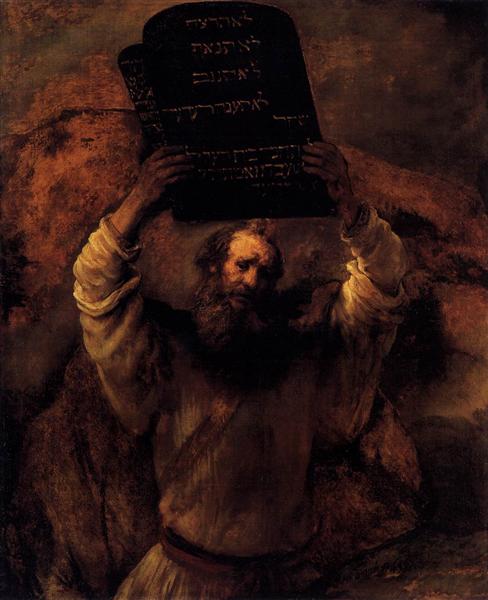Description
Rembrandt's Moses Breaking the Tablets of the Law (1659) is a powerful artistic expression that reflects both the artist's technical mastery and his deep understanding of the human condition. Executed during a mature period of his career, this painting captures a dramatic moment in the biblical narrative and becomes a dissector of emotions, morality and the role of the leader.
In this work, Rembrandt presents the central figure of Moses in a moment of pure anger and frustration, holding in one hand the tablets of the Law that he has just smashed. The composition is remarkable, as the artist uses the contrast between Moses' figure and the surroundings to draw the viewer's attention to the violence of his action. Moses, with his strong, muscular face, is wrapped in a cloak of earthy tones that highlights his humanity, while the dark, sombre background envelops the scene in an atmosphere of tension. This use of chiaroscuro is characteristic of Rembrandt and emphasises the internal conflict that the prophet experiences.
The colour palette used in the painting is predominantly dark, with flashes of light accentuating the figure of Moses. The light seems to emanate from him, creating a halo of energy that highlights both his figure and his action. This use of colour not only guides the viewer's gaze, but also echoes the drama of the moment. The brown and grey tones that predominate in the background contrast effectively with the luminous whites of the panels, suggesting the struggle between divine law and human fallibility.
In the moment depicted by Rembrandt, Moses is not alone. Although his figure is the most prominent, shadows of other characters can be seen at the bottom of the painting, seemingly watching in wonder and fear. The ambiguity of their forms invites the viewer to reflect on the consequences of Moses' anger, as well as the impact it has on those who witness his fury. They are not given clear individuality, which can be interpreted as a symbol of the community that suffers the repercussions of his error.
Another fascinating aspect of this work is its historical context and its relationship to Baroque art. Rembrandt, like many of his contemporaries, was influenced by the dramatic narrative and emotional contrasts that characterize this movement. However, unlike his peers, his approach is not limited to magnificence or exaltation of subjects; instead, he seeks introspection and vulnerability. It is this psychological depth that allows his work to resonate with a universal humanity.
"Moses Breaking the Tablets of the Law" is one of those works that transcends its narrative content. Through an almost visceral approach, Rembrandt allows the viewer to feel Moses' frustration and despair. The falling tablets symbolize not only the breaking of a divine covenant, but also the fragility of human laws and the inevitable failure of human nature. In his depiction of the religious theme, the artist invites deeper reflection on morality, authority, and the emotions that move us.
In conclusion, this painting by Rembrandt stands as a testament to his artistic genius in combining technique, emotion and narrative into a single visually striking work. His ability to immerse the viewer in the experience of his subject is a reflection of his deep understanding of human nature and his constant search for universal truths through art.
KUADROS ©, a famous painting on your wall.
Hand-made oil painting reproductions, with the quality of professional artists and the distinctive seal of KUADROS ©.
Painting reproduction service with satisfaction guarantee. If you are not completely satisfied with the replica of your painting, we will refund 100% of your money.

